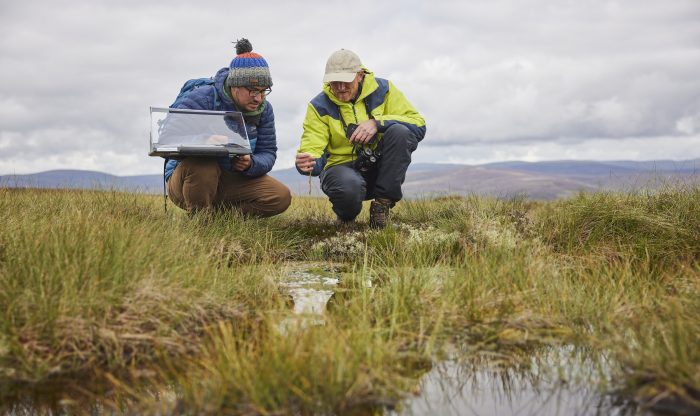Scotland’s National Parks in world first as they join Race to Zero
25th July 2024

The UK’s National Parks, including Loch Lomond and The Trossachs and The Cairngorms, have become the first in the world to join the UN-backed ‘Race to Zero’ initiative, aiming to halve their global carbon emissions by 2030 and become significant net carbon sinks by 2050.
The collective commitment from the 15 National Parks will transform an area almost 35 times the size of Glasgow (610,000 hectares), restoring the land on a huge scale, increasing its ability to capture carbon. This will see them work with partners and local communities on nature-friendly practices, sustainable travel, renewable energy and sustainably-produced food.
The landscapes within Scotland’s National Parks are particularly suitable for soaking up carbon and greenhouse gases, with huge areas of peatland and woodland.
Collectively, Loch Lomond & The Trossachs and Cairngorms National Parks restored over 1,793 hectares of peatland in 2023/2024. This vital restoration helps turn degraded peatland that is emitting carbon and other greenhouse gases into one which locks them up and over time, absorbs them from the atmosphere.
Loch Lomond and The Trossachs National Park Authority recently published a new National Park Partnership Plan which sets out a long-term vision for the National Park as ‘a thriving place that is nature positive and carbon negative’. The plan sets out a wide range of measures required for the National Park to reach net zero by 2035 including more tree planting, sustainable transport services and affordable housing for local people.
The Cairngorms National Park Authority published their National Park Partnership Plan in August 2022, which includes a commitment to becoming ‘a carbon negative and biodiversity rich National Park’. Key to this will be the £43 million, National Lottery Heritage Fund-supported Cairngorms 2030 programme, which will see the Cairngorms become the UK’s first net zero National Park. Across 20 long-term projects, Cairngorms 2030 will bring about transformational change in the Cairngorms, benefitting people’s health and wellbeing, delivering on climate change and enhancing nature across the National Park.
Sandy Bremner, Convener of the Cairngorms National Park Authority, said: “We are proud – alongside 14 other UK National Parks – to join the Race to Zero initiative. Our National Parks have a crucial role to play in turning the dialogue around climate change into positive action on the ground, working with local communities, farmers and land managers, businesses, visitors and others to ensure that people and nature thrive together.
“Thanks to our groundbreaking Cairngorms 2030 programme, we are committed to becoming the UK’s first net zero National Park and, by sharing our progress every step of the way, hope to inspire rural communities both here in Scotland and across the world to join us on the journey.”
Heather Reid, Convener for Loch Lomond and the Trossachs National Park Authority said: “The Race to Zero initiative is driving global action and the UK’s National Parks have an opportunity, and a responsibility, to step up and realise our potential in tackling the climate and nature crises.
“Tackling these twin crises is not separate to supporting the rural economy and our communities. In fact, working together to address these will provide a range of wider benefits for the National Park and its people, including more investment, business and employment opportunities.
“Collaboration is key to facing these challenges. Locally, we will work closely with partners and communities to future-proof our National Park, and nationally, we will join with other UK National Parks in the Race to Zero.”
Cairngorms National Park case study
The Cairngorms 2030 programme is putting the power to tackle the nature and climate crisis in the hands of the people who live, visit and work in the UK’s largest National Park. Bringing together 74 partners across 20 connected projects, over the next five years the programme will transform the way land is managed and used to benefit nature, empower communities to shape the future of their local area, make getting around the Cairngorms easier, safer and greener, and foster healthier, happier communities with wellbeing at their heart.
The programme includes 6,500 hectares of peatland restoration, the creation of over 300 football pitches of new woodland per annum, a net zero farming pilot scheme, the creation of the world’s first outdoor dementia centre, and a range of transformational active travel and public transport projects.
The Cairngorms National Park is also home to the UK’s largest habitat restoration project – Cairngorms Connect – which covers 10% of the National Park’s area. Cairngorms Connect is a partnership of public, private and third sector partners, committed to a bold and ambitious 200-year vision to enhance habitats, species and ecological processes across a vast area within the Cairngorms National Park.
Loch Lomond & The Trossachs National Park case study
In the north of the National Park, local communities and land managers are working with the National Park Authority and Loch Lomond and The Trossachs Countryside Trust on Wild Strathfillan, a nature restoration initiative across an area of 50,000 hectares.
Wild Strathfillan aims to deliver nature restoration work alongside traditional rural industries that underpin the local economy and employ local people – for example, farming, forestry, and deer stalking.
The Strathfillan landscape within Loch Lomond & The Trossachs is unique and biologically important. It features a diverse range of habitats including the National Park’s only remaining Caledonian pinewoods and many of Scotland’s most iconic species can be found here, including Black Grouse, Red Squirrel, and Osprey.
A specialist plant nursery set up as part of the project has seen National Park staff Board members and volunteers donate more than 480 hours of their time collecting and planting 35,000 native tree seeds, which will eventually be planted out across the Strathfillan landscape, expanding native woodlands and creating wildlife corridors.
This week, the project received £1.1m funding from the Scottish Government’s Nature Restoration Fund.